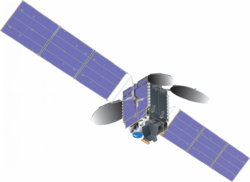Physics:Tropospheric Emissions: Monitoring of Pollution
 TEMPO attached to a communications satellite. | |
| Operator | NASA |
|---|---|
| Manufacturer | Ball Aerospace |
| Instrument type | UV/Vis spectrometer |
| Function | Atmospheric chemistry and pollution monitoring |
| Began operations | 2022 (planned)[1][2] |
| Website | tempo |
| Properties | |
| Resolution | 0.6 nm |
| Spectral band | 290–740 nm (UV, Vis) |
| Host spacecraft | |
| Spacecraft | Intelsat 40e[3] |
| Operator | Intelsat |
| Launch date | 2022 (planned) |
| Rocket | Falcon 9 (SpaceX) |
| Launch site | Cape Canaveral |
| Orbit | Geostationary |
Tropospheric Emissions: Monitoring of Pollution (TEMPO) is a NASA Earth Venture-Instrument that will measure North American pollution at a high resolution and on an hourly basis.[4] It is an ultraviolet–visible spectrometer maintaining a constant view of North America, enabling it to provide daily data on ozone, nitrogen dioxide, and other elements in the atmosphere.
TEMPO is intended to be attached as payload on a commercial geostationary communication satellite with a constant view of the face of the Earth. TEMPO's light-collecting mirror scans a complete and constant east to west field of regard (FOR). TEMPO detectors measure reflected sunlight to and from the Earth's surface and atmosphere.[5] TEMPO "monitors air quality from Mexico to Canada" with "scientists from both Mexico and Canada sharing TEMPO activities taking place in their home countries".[6] TEMPO will form part of a geostationary constellation of pollution-monitoring assets, along with the planned Sentinel-4 from ESA and Geostationary Environment Monitoring Spectrometer (GEMS) from South Korea's KARI.[7]
On 3 February 2020, Intelsat announced that the Intelsat 40e satellite, planned for launch in 2022, will host TEMPO. Maxar Technologies, the builder of the satellite, is responsible for payload integration.[1][2]
Earth Venture-Instrument program
TEMPO, which is a collaboration between NASA and the Smithsonian Astrophysical Observatory, is NASA's first Earth Venture-Instrument (EVI) mission.[4][8] The EVI program is an element within the Earth System Science Pathfinder (ESSP) program office, which is under NASA's Science Mission Directorate Earth Science Division (SMD/ESD). EVI's are a series of innovative "science-driven, competitively selected, low cost missions". The series of "Venture Class" missions were recommended in the 2007 publication Earth Science and Applications from Space: National Imperatives for the Next Decade and Beyond.[9] "[I]nnovative research and application missions that might address any area of Earth science" are selected through frequent "openly-competed solicitations".[10]
Earth Venture missions are "small-sized competitively selected orbital missions and instrument missions of opportunity" and include NASA-ISRO Synthetic Aperture Radar (NISAR), Surface Water and Ocean Topography (SWOT), ICESat-2, SAGE III on ISS, Gravity Recovery and Climate Experiment Follow On (GRACE-FO), Cyclone Global Navigation Satellite System (CYGNSS), Ecosystem Spaceborne Thermal Radiometer Experiment on Space Station (ECOSTRESS), and the Global Ecosystem Dynamics Investigation lidar (GEDI).[11]
References
- ↑ 1.0 1.1 "Maxar Technologies Will Build Next-Generation Intelsat Epic Geostationary Communications Satellite with NASA Hosted Payload". Maxar Technologies (Press release). Business Wire. 3 February 2020. Retrieved 3 February 2020. External link in
|publisher=(help) - ↑ 2.0 2.1 Werner, Debra (22 July 2019). "Maxar to install NASA pollution sensor on commercial satellite". SpaceNews. https://spacenews.com/maxar-to-install-nasa-pollution-sensor-on-commercial-satellite/. Retrieved 18 November 2019.
- ↑ https://spaceflightnow.com/2020/03/17/spacex-selected-to-launch-intelsat-telecom-satellite-nasa-pollution-monitor/ - 18 March 2020
- ↑ 4.0 4.1 "TEMPO Twitter page". https://twitter.com/TEMPO_Mission. ""TEMPO will measure pollution of N. America hourly at high spatial resolution. NASA's first Earth Venture Instrument mission is a collaboration with Smithsonian"."
- ↑ "TEMPO Instrument". Smithsonian Astrophysical Observatory. http://tempo.si.edu/instrument.html.
- ↑ @TEMPO_Mission (5 June 2019). "TEMPO is a North American instrument...". https://twitter.com/TEMPO_Mission/status/1136314643159355393.
- ↑ Zoogman, P. (January 2017). "Tropospheric emissions: Monitoring of pollution (TEMPO)". Journal of Quantitative Spectroscopy and Radiative Transfer 186: 17–39. doi:10.1016/j.jqsrt.2016.05.008. PMID 32817995. PMC 7430511. Bibcode: 2017JQSRT.186...17Z. https://arroma.uiowa.edu/docs/publication/paper_pdf/2017/Zoogman.pdf.
- ↑ "Missions: Earth Venture-Instrument". NASA. https://eospso.nasa.gov/mission-category/55. Retrieved 5 June 2019.
- ↑ Earth Science and Applications from Space: National Imperatives for the Next Decade and Beyond. National Academies Press. 2007. doi:10.17226/11820. ISBN 978-0-309-66714-2.
- ↑ "Missions: Venture Class". NASA. https://eospso.nasa.gov/mission-category/13. Retrieved 5 June 2019.
- ↑ Neeck, Steven P. (October 2015). "The NASA Earth Science Flight Program: An update". in Meynart, Roland; Neeck, Steven P; Shimoda, Haruhisa. Sensors, Systems, and Next-Generation Satellites XIX. 9639. 963907. doi:10.1117/12.2199919. ISBN 978-1-62841-849-1. Bibcode: 2015SPIE.9639E..07N.
External links
- TEMPO website by the Smithsonian Astrophysical Observatory
 |

